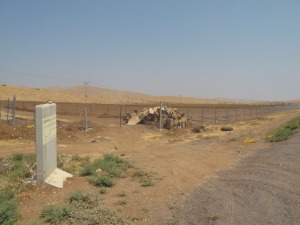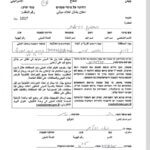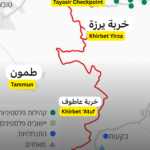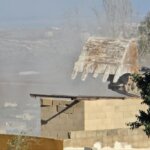How the East is Won: Ro’i settlement steals more Palestinian land
Jane Harrie’s Blog: 7th August 2012:
 We already knew that there was a problem in Al Hadidiya in the Jordan Valley. On 19th July we had passed land belonging to the community to see that an area directly adjacent to the ‘Danger Firing Zone’ sign had been fenced off and freshly ploughed. In Area C and in a military firing zone, we knew that this could only be the work of settlers – presumably from nearby Roi settlement. Returning on 27th July, this looks very much like a ‘fait accompli’. The ploughed land is much more extensive, and neat rows of young grape vines connected by irrigation pipes give the confiscation an air of orderliness and solidity. Only the piled boxes in one corner of the field betray the speed with which this ‘land grab’ took place. The extent takes our breath away. ‘Take some pictures quickly’, says Ghassan edgily, as he pulls his service over onto the edge of the road and puts up the bonnet, as though dealing with a break-down problem. One never knows when the army may turn up.
We already knew that there was a problem in Al Hadidiya in the Jordan Valley. On 19th July we had passed land belonging to the community to see that an area directly adjacent to the ‘Danger Firing Zone’ sign had been fenced off and freshly ploughed. In Area C and in a military firing zone, we knew that this could only be the work of settlers – presumably from nearby Roi settlement. Returning on 27th July, this looks very much like a ‘fait accompli’. The ploughed land is much more extensive, and neat rows of young grape vines connected by irrigation pipes give the confiscation an air of orderliness and solidity. Only the piled boxes in one corner of the field betray the speed with which this ‘land grab’ took place. The extent takes our breath away. ‘Take some pictures quickly’, says Ghassan edgily, as he pulls his service over onto the edge of the road and puts up the bonnet, as though dealing with a break-down problem. One never knows when the army may turn up.
 For Abu Sakker, the head of Al Hadidiya community, this is just the latest incident in an ongoing struggle for local people to subsist safely on their land. Even getting to speak to him is a challenge. We could have reached his tent easily from the road, but this way is blocked by an agricultural gate – ostensibly for ‘security’. We drive a considerable way round and jolt our way along a potholed track which must be virtually impassable in winter. He tells us that he used to have to phone the International Committee of the Red Cross (ICRC) or the Israeli District Commanding Officer (DCO) to get the gate opened, but since about 3 months ago it is closed all the time. Lack of access to roads means difficulty in obtaining materials essential to survival, such as water. As this is Area C and a military area, Palestinians are forbidden to build any ‘structures’, including water tanks, and these can be confiscated by the military. As if to prove the point, a lorry carrying a water tank hurries past, raising a cloud of dust. ‘Illegal’ structures can receive demolition orders at any time. The last service of a demolition order Abu Sakker is aware of happened in the nearby community of Ras al Ahmar 5 days ago. Traditionally, farmers here produced wheat and barley, but it is forbidden for them to make a well or pool to conserve water. Just how much can people take, we wonder?
For Abu Sakker, the head of Al Hadidiya community, this is just the latest incident in an ongoing struggle for local people to subsist safely on their land. Even getting to speak to him is a challenge. We could have reached his tent easily from the road, but this way is blocked by an agricultural gate – ostensibly for ‘security’. We drive a considerable way round and jolt our way along a potholed track which must be virtually impassable in winter. He tells us that he used to have to phone the International Committee of the Red Cross (ICRC) or the Israeli District Commanding Officer (DCO) to get the gate opened, but since about 3 months ago it is closed all the time. Lack of access to roads means difficulty in obtaining materials essential to survival, such as water. As this is Area C and a military area, Palestinians are forbidden to build any ‘structures’, including water tanks, and these can be confiscated by the military. As if to prove the point, a lorry carrying a water tank hurries past, raising a cloud of dust. ‘Illegal’ structures can receive demolition orders at any time. The last service of a demolition order Abu Sakker is aware of happened in the nearby community of Ras al Ahmar 5 days ago. Traditionally, farmers here produced wheat and barley, but it is forbidden for them to make a well or pool to conserve water. Just how much can people take, we wonder?
 Returning to the issue of the recently confiscated land opposite Roi settlement, Abu Sakker tells us that the extent is 170 dunums, and that it belongs to 3 brothers from Tubas governate. We note down the names, knowing that this may enable us to put them in contact with a lawyer and groups such as the Israeli Human Rights organisation Yesh Din. This is the brothers’ only chance of reclaiming their land – but it’s a slim one, and would entail producing a series of papers, including proof of ownership. Even then a case is unlikely to succeed, as large swathes of the Jordan Valley and Dead Sea area have been designated as a closed military zone – approximately 56% of the area according to a recent fact sheet published by the UN Office for the Coordination for Humanitarian Affairs (OCHA). This means that Palestinian presence in these areas is formally prohibited without permission from the Israeli authorities, which is rarely granted. At the same time the OCHA report states that 10 Israeli settlements and settlement outposts are located either partially of wholly in military firing zones, and cultivation of the land seems to go on unimpeded there. We have seen the newly-ploughed field for ourselves, directly adjacent to the ‘Danger – Firing Zone’ sign.
Returning to the issue of the recently confiscated land opposite Roi settlement, Abu Sakker tells us that the extent is 170 dunums, and that it belongs to 3 brothers from Tubas governate. We note down the names, knowing that this may enable us to put them in contact with a lawyer and groups such as the Israeli Human Rights organisation Yesh Din. This is the brothers’ only chance of reclaiming their land – but it’s a slim one, and would entail producing a series of papers, including proof of ownership. Even then a case is unlikely to succeed, as large swathes of the Jordan Valley and Dead Sea area have been designated as a closed military zone – approximately 56% of the area according to a recent fact sheet published by the UN Office for the Coordination for Humanitarian Affairs (OCHA). This means that Palestinian presence in these areas is formally prohibited without permission from the Israeli authorities, which is rarely granted. At the same time the OCHA report states that 10 Israeli settlements and settlement outposts are located either partially of wholly in military firing zones, and cultivation of the land seems to go on unimpeded there. We have seen the newly-ploughed field for ourselves, directly adjacent to the ‘Danger – Firing Zone’ sign.
The point, says Abu Sakker, is not the 170 dunums, but the political strategy he sees behind it – to drive the Palestinians out of the area or to make life so unbearable that they leave of their own accord. So this is how the East of the West Bank is won. Little by little, piece of land by piece of land, the strategy seems to be succeeding.






